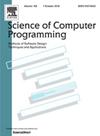机器人行为规划中正式方法与临时实施的实证评估
IF 1.4
4区 计算机科学
Q3 COMPUTER SCIENCE, SOFTWARE ENGINEERING
引用次数: 0
摘要
随着自主机器人系统融入各个领域,确保其安全运行变得越来越重要。考虑到现实世界环境固有的复杂性和不确定性,保证网络物理系统的安全决策是一项关键挑战。Gwendolen、vGOAL 和 Tumato 等工具能够使用形式化方法为正确、安全的决策提供保证。本文涉及的 Tumato 是一个形式化规划框架,它能从声明式规范中生成完整的行为。Tumato 通过避免不安全的行为和状态来确保安全性,同时通过考虑行为的非确定性结果来实现稳健性。虽然形式化方法声称可以管理复杂性、提供安全保证并确保稳健性,但要验证这些说法,实证评估是必要的。这项工作介绍了一项实证研究,比较了各种临时行为规划实现(由具有不同计算机科学经验水平的参与者开发)与使用 Tumato 的实现的特点。我们调查了不同方法的可用性,并评估了 i) 它们的有效性,ii) 所实现的安全性(保证),iii) 它们在处理不确定性时的稳健性,以及 iv) 它们的适应性、可扩展性和可伸缩性。我们的分析证实,虽然临时方法提供了一定的开发灵活性,但它们缺乏正式方法所提供的严格安全保证。这项研究支持这样的假设,即在 Tumato 中实施的形式化方法是开发安全自主系统的有效工具,特别是在管理复杂性和确保稳健的决策与规划方面。本文章由计算机程序翻译,如有差异,请以英文原文为准。
An empirical evaluation of a formal approach versus ad hoc implementations in robot behavior planning
As autonomous robotic systems integrate into various domains, ensuring their safe operation becomes increasingly crucial. A key challenge is guaranteeing safe decision making for cyber-physical systems, given the inherent complexity and uncertainty of real-world environments.
Tools like Gwendolen, vGOAL, and Tumato enable the use of formal methods to provide guarantees for correct and safe decision making. This paper concerns Tumato, a formal planning framework that generates complete behavior from a declarative specification. Tumato ensures safety by avoiding unsafe actions and states while achieving robustness by considering nondeterministic outcomes of actions. While formal methods claim to manage complexity, provide safety guarantees, and ensure robustness, empirical evaluation is necessary to validate these claims.
This work presents an empirical study comparing the characteristics of various ad hoc behavior planning implementations (developed by participants with diverse levels of experience in computer science), with implementations using Tumato. We investigate the usability of the different approaches and evaluate i) their effectiveness, ii) the achieved safety (guarantees), iii) their robustness in handling uncertainties, and iv) their adaptability, extensibility, and scalability. To our knowledge, this is the first participant-based empirical study of a formal approach for (safe and robust) autonomous behavior.
Our analysis confirms that while ad hoc methods offer some development flexibility, they lack the rigorous safety guarantees provided by formal methods. The study supports the hypothesis that formal methods, as implemented in Tumato, are effective tools for developing safe autonomous systems, particularly in managing complexity and ensuring robust decision making and planning.
求助全文
通过发布文献求助,成功后即可免费获取论文全文。
去求助
来源期刊

Science of Computer Programming
工程技术-计算机:软件工程
CiteScore
3.80
自引率
0.00%
发文量
76
审稿时长
67 days
期刊介绍:
Science of Computer Programming is dedicated to the distribution of research results in the areas of software systems development, use and maintenance, including the software aspects of hardware design.
The journal has a wide scope ranging from the many facets of methodological foundations to the details of technical issues andthe aspects of industrial practice.
The subjects of interest to SCP cover the entire spectrum of methods for the entire life cycle of software systems, including
• Requirements, specification, design, validation, verification, coding, testing, maintenance, metrics and renovation of software;
• Design, implementation and evaluation of programming languages;
• Programming environments, development tools, visualisation and animation;
• Management of the development process;
• Human factors in software, software for social interaction, software for social computing;
• Cyber physical systems, and software for the interaction between the physical and the machine;
• Software aspects of infrastructure services, system administration, and network management.
 求助内容:
求助内容: 应助结果提醒方式:
应助结果提醒方式:


